Daryo’s All-American Diner
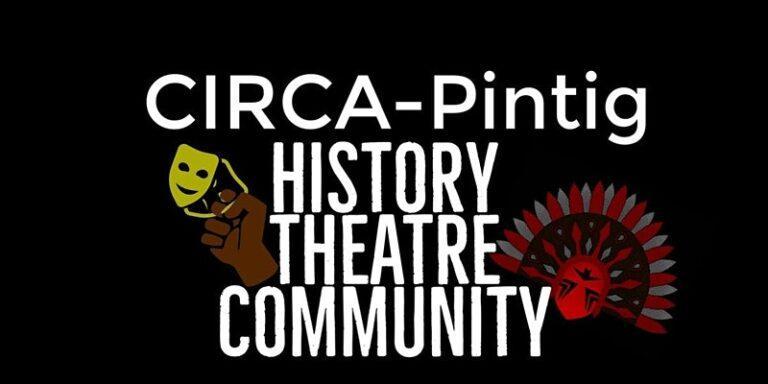


How/Why was the play created?

● Written by Conrad A. Pan aniban
● Daryo’s All-American Diner was commissioned by Circa Pinti to address the rise in anti-AAPI violence in the U.S. durin the COVID-19 pandemic
● A monthly workshop with community members led to the idea o commissionin a play
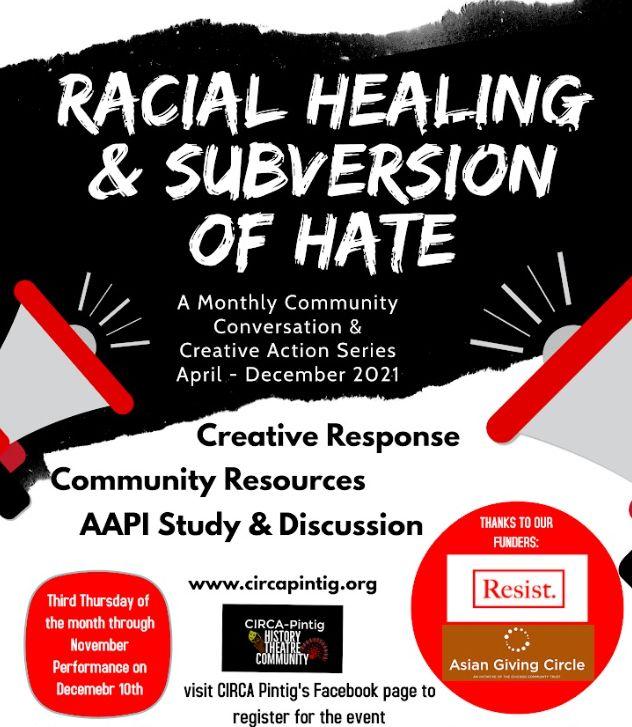
Racial Healing & Subversion of Hate Workshop
“An interactive conversation on con rontin the impact o racial violence and the role o the arts in subvertin the culture o hate a ainst Asian Americans”
Examples o topics covered in the monthly workshop:

● Policin the Asian Body: Re ulatin ‘Otherness’ as Threat to White Privile e
● Interro atin the Asian Body in Western Storytellin : The Politics o Representation
● Is theatre Political or pure contemplation?
● Re-thinkin Drama as Resistance in the Era o Anti-Asian Hate
Some words from the author, Conrad A. Panganiban
“When I was first approached by CIRCA Pinti to write a play that touched on the topic o Anti-AAPI violence in America, it was a dauntin task, but a welcome challen e.…there's a ca e I requent in Alameda, CA where it is run by an Asian amily that serves classic "American" DINER ood. The clientele is very diverse and bein in a small community, it was so encoura in to see how the customers interacted with the staff. So, that seed o ima inin how these diners would react i one o the staff was attacked and how a community can be united because o that act inspired the story o the play.”
“It's very important or audiences carry hope ul resolutions out o the theatre and into their communities to share with riends and amily, especially when it eels like much o the country, communities, and even amilies are divided on so many subjects. As a playwri ht, it's always a dream to be able to put my words into the bodies o amazin artists to show how hope or a better tomorrow can keep a person oin no matter how bleak thin s et. Another thin specifically I'd love or audiences to take away rom DARYO'S ALL-AMERICAN FAMILY, is to remember that each person has a voice. That i a person sees somethin wron done, that they are capable o reachin out or help.”

Who are Asian Americans/ AAPI people?

The 2020 Census:
• shows 19.9 million people identified as Asian alone and 4.1 million people identified as Asian in combination with another race.

•States with the lar est Asian populations (includin those with more than one race) in 2011 were Cali ornia (5.8 million) and New York (1.7 million).
There are over 19.9 million Asian Americans livin in the United States and make up 5.6% o our national total population.
-U.S. Census 2023
2. Immigrant
Population
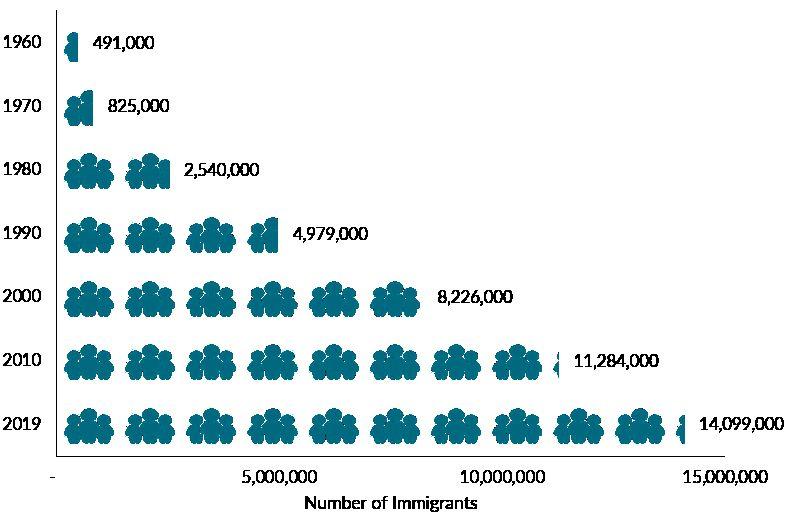

fromAsia in the United States, by Region of Birth, 1960-2019
Source: Data from U.S. Census Bureau 2010 and 2019 American Community Surveys (ACS), and Campbell J. Gibson and Kay Jung, "Historical Census Statistics on the Foreign-born Population of the United States: 1850-2000" (Working Paper no. 81, U.S. Census Bureau, Washington, DC, February 2006), available online.
Figure

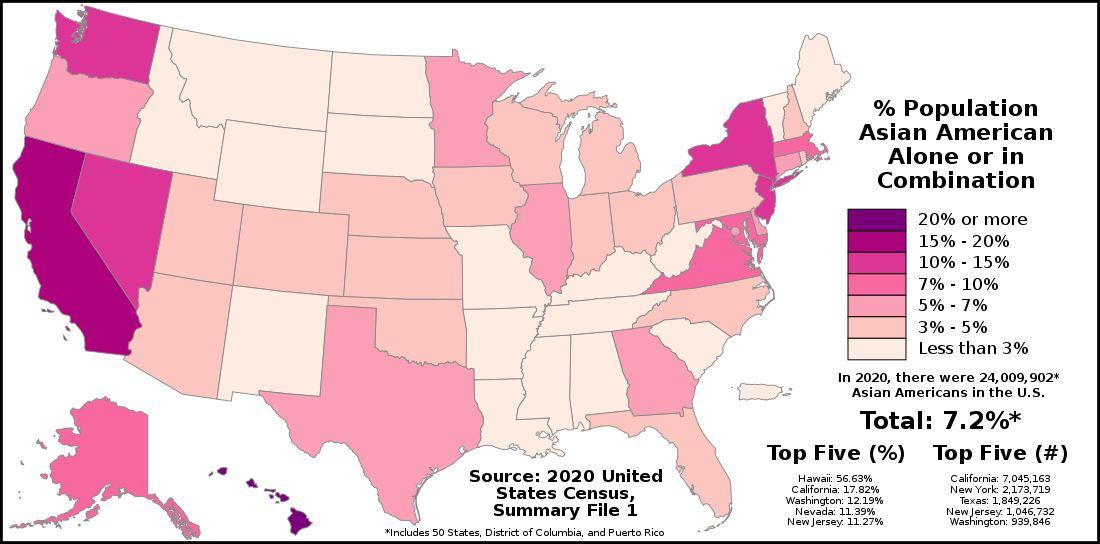
Top Concentration by Metropolitan Area for Immigrants from Asia, 2015-2019
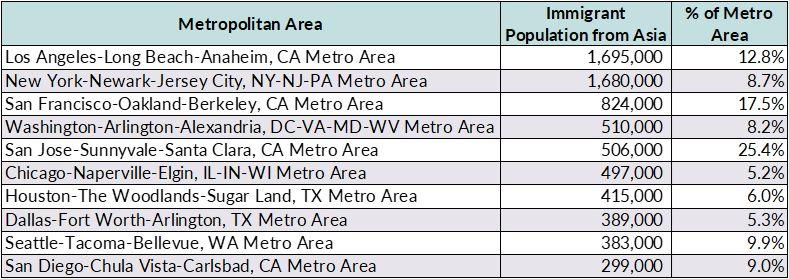
Source: MPI tabulation of data from the U.S. Census Bureau pooled 2015-19 ACS.

Asian Americans are a diverse group
Figure 2. Immigrant Population from Asia in the United States, by Region of Birth, 1960-2019
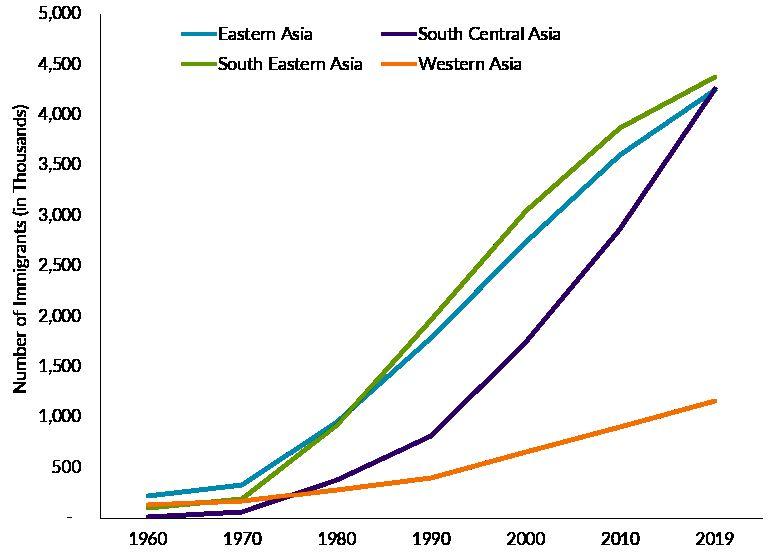
The U.S. Census Bureau defines Asian regions as follows:
Eastern Asia includes China, Hong Kong, Japan, Macau, Mongolia, North Korea, South Korea, and Taiwan.
South Central Asia includes Afghanistan, Bangladesh, Bhutan, India, Iran, Kazakhstan, Kyrgyzstan, the Maldives, Nepal, Pakistan, Sri Lanka, Tajikistan, Turkmenistan, and Uzbekistan.
South Eastern Asia includes Brunei, Cambodia, Indonesia, Laos, Malaysia, Myanmar (Burma), the Philippines, Singapore, Thailand, Timor-Leste (East Timor), and Vietnam.
Western Asia includes Armenia, Azerbaijan, Bahrain, Cyprus, Georgia, Iraq, Israel, Jordan, Kuwait, Lebanon, Oman, Qatar, Saudi Arabia, Syria, Turkey, the United Arab Emirates, and Yemen.
from 2015-2019, US Census-ACS

Asian Americans are a diverse group
Examples o Asian American Identities: Names & Labels
• Asian
• Asian American and Pacific Islander (AAPI),
• Asian Pacific Islander (API)
• Asian Pacific Islander Desi American (APIDA)
Desi
• Blasian
• Filipino/a/x
• Latina, Latino, Latinx
• South Asian American
• West Asian (Middle Eastern and North A rican re ions)
Etc.
“AAPI” or “Asian American”? A Complicated Topic
https://www.youtube.com/watch?v=6bL

wF_KFrZU

Why is there so

much
inequality in the Asian American Community?
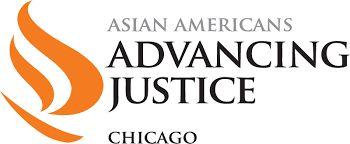
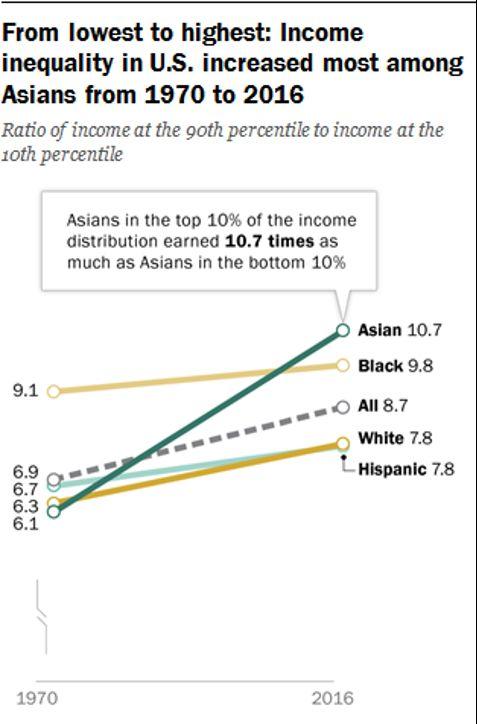
Selective immigration laws
• 1965 Immigration and Nationality Act & 1990 Immigration Act both prioritized “high skilled” immigrants, ex. H1-B visas and E1-5 visas
• Employment/skill-based visas are subject to strict numerical limits
Refugee resettlement starting in 1975
Selective immigration policies + refugees from Asia = huge disparities
Historical Background: “Asian American” Origins
• Political identity in the 1960s
• term that first coined in 1968 by University o Cali ornia raduate students Emma Gee and Yuji Ichioka. Inspired by the Black Power movement, the American Indian movement, and the anti-war movement, Gee and Ichioka wanted a term that could serve as an umbrella term to brin to ether disparate Asian ethnic roups to ether in one voice to advocate or their ri hts.
• AAPI = Asian American and Pacific Islander

• Asian Americans = 28 different countries
• Pacific Islander Americans = 22 different countries
• Commonly used re ional roupin s:

• East Asia (China, Japan, Korea, and more)
• South Asia (India, Pakistan, Ban ladesh, and more)
• Southeast Asia (Vietnam, Indonesia, Philippines, and more)
• Pacific Islands (Hawaii, Ton a, Guam, and more)
Anti-Immi rant and Anti-Re u ee

History: Effects on Asians in the U.S.
Colonial period (1609–1775): influenced modern immi ration processes, policies, & approaches to race/ethnicity, social class, etc.
Revolutionary period (1776–1840): stron anti- orei n values influenced present-day definitions o who is eli ible or citizenship. Old Immi ration period (1841–1882): judicial and public actions led to ethnocentric ederal immi ration policies a ainst Asian immi rants. Nationality Act o 1870 (revised 1970): extended naturalization ri hts continued to exclude Asians.
Experiences in Racism

Perpetual Forei ner
● Nationality Act o 1790
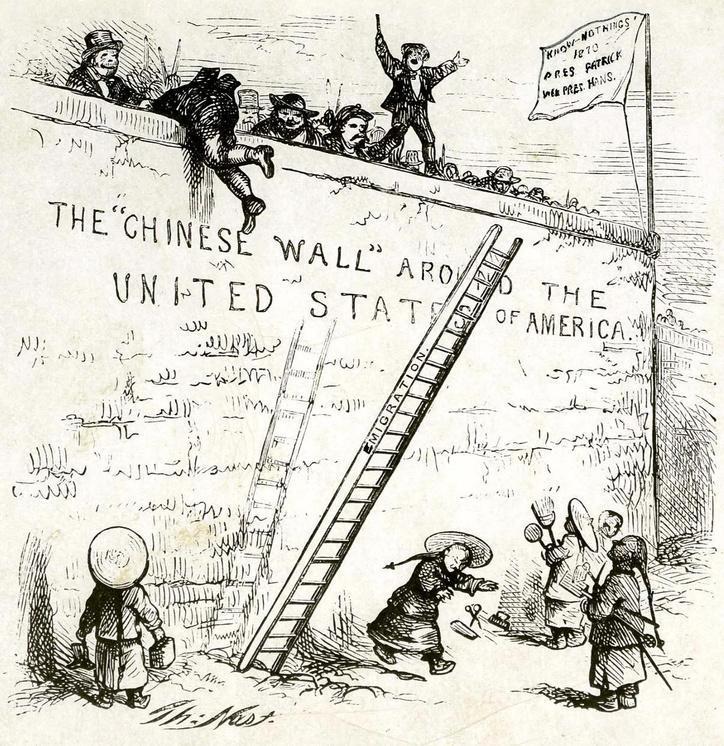
” ree white person”
● Naturalization Act o 1870
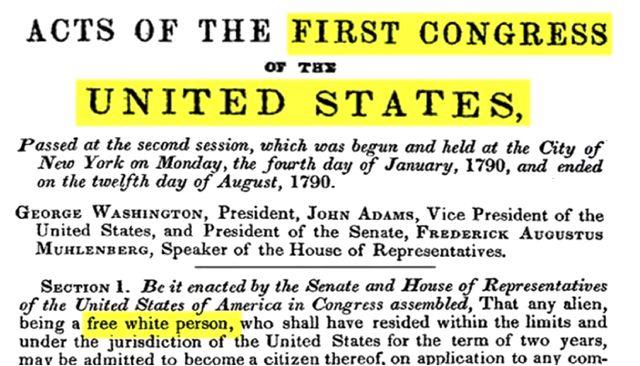
“... aliens bein ree white persons, and to aliens o A rican nativity and to persons o A rican descent.”

Experiences in Racism

Yellow Peril
● 1882 Chinese Exclusion Act
● 1924 Immi ration Act
● 1898 United States v. Won Kim Ark
“This is a race utterly orei n to us and never will assimilatewithus”andChinese“wouldhaverootedout the American population i it weren’t or the exclusion act.” - US Supreme Court Justice Harlan

Model Minority Honorary White
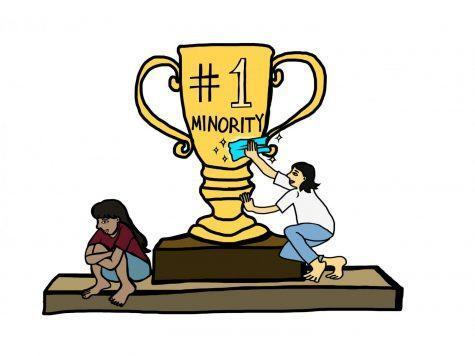
● 1923 United States vs. Bha at Sin h Thind
– US Supreme Court
“Itisamattero amiliarobservationandknowled ethat thephysical roupcharacteristicso theHindusrender themreadilydistin uishable romthevarious roupso personsinthiscountrycommonlyreco nizedaswhite.”
Re erenced in the Play: Vincent Chin
● 27-year-old Chinese American man rom the Detroit, Michi an area
● In 1982, con ronted by two white men while celebratin his bachelor party. They were upset about layoffs in the auto industry durin a time when the Japanese auto industry was doin well in the U.S.
● Beaten by the men later that ni ht and died as a result our days later
Who Killed Vincent Chin? Trailer
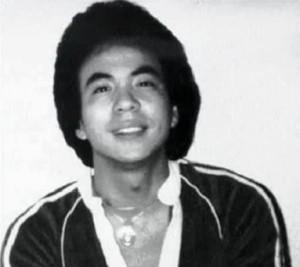
https://www.amdoc.or /watch/media/1669/
Vincent Who? Trailer
https://www.youtube.com/watch?v=I_rwnyM1vtE

Re erenced in the Play: Larry Itlion
● Filipino American labor leader
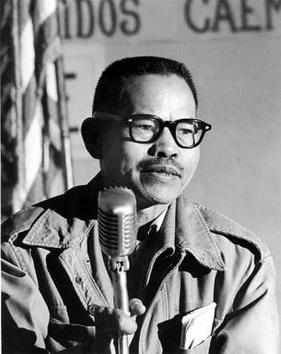
● In 1930s, or anized unions on the West Coast
● ounded the Filipino Farm Labor Union in 1956, and the multi-ethnic A ricultural Workers Or anizin Committee (AWOC) in 1959
● Led the Delano Grape Strike (started in 1965), which eventually led to the ormation o the United Farm Workers
How Mexican and Filipino workers came to ether
https://www.youtube.com/watch?v=DavaNXnJd7c

Larry Itlion inducted into Cali ornia Hall o Fame
https://www.youtube.com/watch?v=w3 PrSoheVY
Moving Forward
Work bein done in response to anti-AAPI hate
● Response to March 2021 mass shootin s in Atlanta
https://www.pbs.or /video/risin -a ainst-asian-hate-oneday-march-preview-hxedpy/

● Bystander Intervention Trainin s
https://www.advancin justice-chica o.or /what-we-do/by stander-intervention-trainin s-2/
● Stop AAPI Hate
https://stopaapihate.or /
● AAP(I Belon )
https://aapibelon .com/
“As we move on to the next journey in li e, don’t ever or et what brou ht us to this pointthe moments o pure joy, the lessons learned rom bein hurt, and above all knowin what true love eels like rom your riends and amily-- or it is those thin s that will keep you movin orward no matter how many times you want to ive up.”
—Daryo’s All-American Diner, Scene 7





















